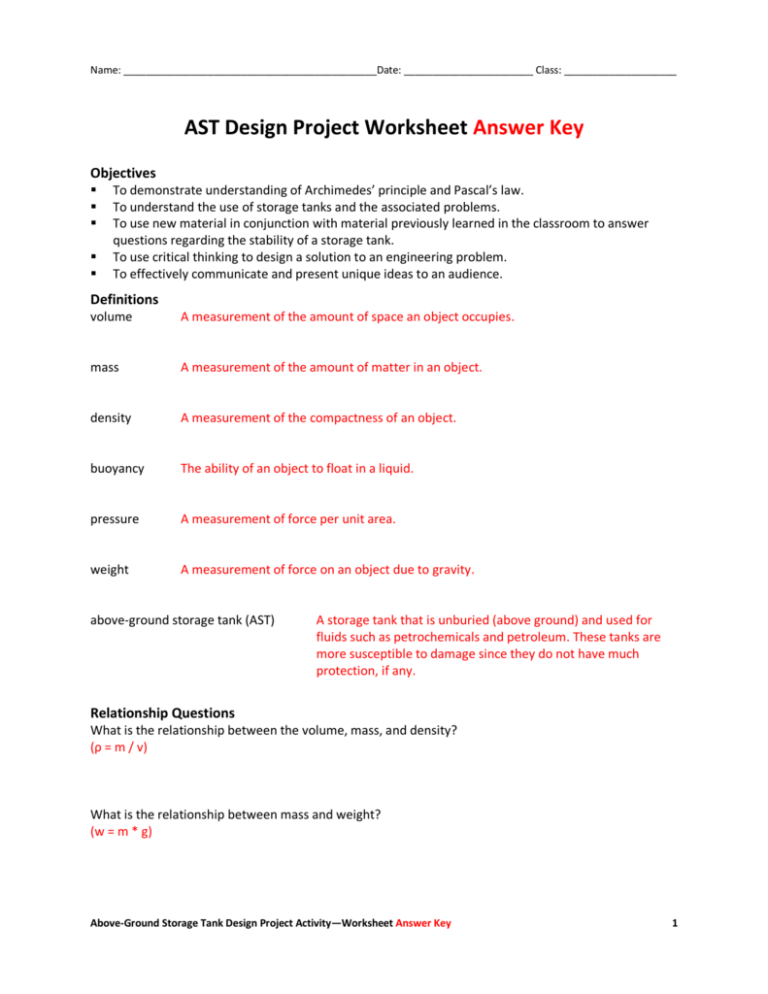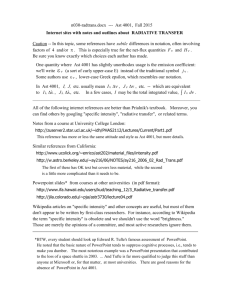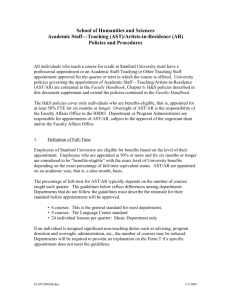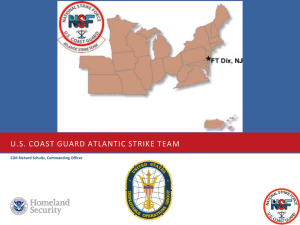AST Design Project Worksheet Answer Key
advertisement

Name: _____________________________________________Date: _______________________ Class: ____________________ AST Design Project Worksheet Answer Key Objectives To demonstrate understanding of Archimedes’ principle and Pascal’s law. To understand the use of storage tanks and the associated problems. To use new material in conjunction with material previously learned in the classroom to answer questions regarding the stability of a storage tank. To use critical thinking to design a solution to an engineering problem. To effectively communicate and present unique ideas to an audience. Definitions volume A measurement of the amount of space an object occupies. mass A measurement of the amount of matter in an object. density A measurement of the compactness of an object. buoyancy The ability of an object to float in a liquid. pressure A measurement of force per unit area. weight A measurement of force on an object due to gravity. above-ground storage tank (AST) A storage tank that is unburied (above ground) and used for fluids such as petrochemicals and petroleum. These tanks are more susceptible to damage since they do not have much protection, if any. Relationship Questions What is the relationship between the volume, mass, and density? (ρ = m / v) What is the relationship between mass and weight? (w = m * g) Above-Ground Storage Tank Design Project Activity—Worksheet Answer Key 1 Name: _____________________________________________Date: _______________________ Class: ____________________ Questions 1. How many hurricanes occurred during the year that you were born? _______ List all hurricanes with name, date and brief description including category, effects, landfall location and other interesting features. Answers will vary as different students research this question and report their findings. 2. What U.S. group is responsible for tracking and predicting weather systems in the tropics? The National Hurricane Center (NHC), located at the Florida International University in Miami, FL, is the division of the National Weather Service responsible for tracking and predicting weather systems within the tropics between the Prime Meridian and the 140th meridian west poleward to the 30th parallel north in the northeast Pacific ocean and the 31st parallel north in the northern Atlantic ocean. Its Tropical Analysis and Forecast Branch (TAFB) routinely issues marine forecasts, in the form of graphics and high seas forecasts, for this area year round. Source: NHC http://en.wikipedia.org/wiki/National_Hurricane_Center 3. What types of failure do ASTs experience? What specifically causes these failures? Displacement (or uplift) – flooding Buckling (or rupture) – external water pressure (flooding), debris, wind impact, wave impact 4. How does Archimedes’ principle apply to ASTs? Archimedes’ principle states that the buoyant force is equal to the weight of the water displaced by the boat. If the weight of the water around the AST (due to surge) is greater than the weight of the AST, the AST will displace. 5. How does Pascal’s law apply to ASTs? Pascal’s law states that a pressure applied at any point on a confined incompressible fluid is transmitted equally throughout the fluid. The surge creates an increased hydrostatic pressure gradient on the AST, which pressurizes the entire AST and can lead to buckling (rupture). Above-Ground Storage Tank Design Project Activity—Worksheet Answer Key 2 Name: _____________________________________________Date: _______________________ Class: ____________________ Design Project 1. Derive an equation for the weight of the AST. Hint: Units should be (lb) which is lbm. If you get units of (ft*lb/s2), you found weight in lbf. Surface area (SA) of cylinder: SA = 2r2 + 2rh OR 2d2/4 + dh Volume (V) of cylinder itself = SA *t **Note: t is thickness of steel shell V = (2r2 + 2rh)t OR (2d2/4 + dh)t Mass (m) of AST = V * s (lbm) m = (2r2 + 2rh)ts OR (2d2/4 + dh)ts This step not needed, but most students will make this mistake: Weight (w) of AST = m * g (lbf) w = (2r2 + 2rh)tsg OR (2d2/4 + dh)tsg 2. Derive an equation for the weight of the liquid inside the AST. Hint: Units should be (lb), which is lbm. If you get units of (ft*lb/s2), you found weight in lbf). Volume (V) inside cylinder = A * h = A* L A = r2 OR d2/4 V = r2L OR (d2/4)L **Note: use liquid level (L) instead of AST height (h) Mass (m) of liquid in AST = V * L (lbm) m = r2LL OR (d2/4)LL This step not needed, but most students will make this mistake: Weight (w) of liquid in AST = m * g (lbf) w = r2LLg OR (d2/4)LLg 3. Derive an equation for the weight of the water displaced (Hint: units should be (lb) which is lbm, if you get units of (ft*lb/s2) you found weight in lbf) Volume (V) inside cylinder = A * h = A* S **Note: use surge height (S) instead of AST height (h) A = r2 OR d2/4 2 2 V = r L OR (d /4)S Mass (m) of water displaced by AST = V * w (lbm) m = r2Sw OR (d2/4)Sw This step not needed, but most students will make this mistake: Weight (w) of water displaced by AST = m * g (lbf) w = r2Swg OR (d2/4)Swg Above-Ground Storage Tank Design Project Activity—Worksheet Answer Key 3 Name: _____________________________________________Date: _______________________ Class: ____________________ 4. Use the equations you derived in questions 1, 2, and 3 to derive an expression to determine whether or not the AST will displace or remain stationary in the case of a flood. weight of the AST + weight of the liquid inside the AST > weight of the water displaced (2r2 + 2rh)ts + r2LL > r2Sw OR (2d2/4 + dh)ts + (d2/4)LL > (d2/4)Sw USING gravity, g: (2r2 + 2rh)tsg + r2LLg > r2Swg OR (2d2/4 + dh)tsg + (d2/4)LLg > (d2/4)Swg Your Design Criteria Group 1 Diameter, d (ft) Height, h (ft) Steel type Density of steel, ρs (lb/in3) Shell thickness, t (in) Petrochemical type Density of petrochemical, ρL (kg/m3) Height of petrochemical, L (ft) Density of water, ρw (kg/m3) Surge height, S (ft) 25 10 ASTM A36 0.284 0.25 (maximum allowable thickness = 1.5) Ethylene 1.178 5 1000 1 Group 2 Diameter, d (ft) Height, h (ft) Steel type Density of steel, ρs (lb/in3) Shell thickness, t (in) Petrochemical type Density of petrochemical, ρL (kg/m3) Height of petrochemical, L (ft) Density of water, ρw (kg/m3) Surge height, S (ft) 40 15 ASTM A131, Grade A 0.284 0.5 (maximum allowable thickness = 0.5) Propylene 1.81 15 1000 2 Group 3 Diameter, d (ft) Height, h (ft) Steel type Density of steel, ρs (lb/in3) Shell thickness, t (in) Petrochemical type Density of petrochemical, ρL (kg/m3) Height of petrochemical, L (ft) Density of water, ρw (kg/m3) Surge height, S (ft) 65 20 ASTM A283, Grade C 0.284 0.25 (maximum allowable thickness = 1) Butadiene 640 10 1000 7 Above-Ground Storage Tank Design Project Activity—Worksheet Answer Key 4 Name: _____________________________________________Date: _______________________ Class: ____________________ Group 4 Diameter, d (ft) Height, h (ft) Steel type Density of steel, ρs (lb/in3) Shell thickness, t (in) Petrochemical type Density of petrochemical, ρL (kg/m3) Height of petrochemical, L (ft) Density of water, ρw (kg/m3) Surge height, S (ft) 80 25 ASTM A285, Grade C 0.284 0.25 (maximum allowable thickness = 1) Benzene 876.5 10 1000 8 Group 5 Diameter, d (ft) Height, h (ft) Steel type Density of steel, ρs (lb/in3) Shell thickness, t (in) Petrochemical type Density of petrochemical, ρL (kg/m3) Height of petrochemical, L (ft) Density of water, ρw (kg/m3) Surge height, S (ft) 90 30 ASTM A516, Grade 55 0.284 0.5 (maximum allowable thickness = 1.5) Toluene 866.9 5 1000 8 5. For what purposes is this type of steel commonly used? (Cite your sources!) GROUP 1 (ASTM A36): Steel shapes, plates and bars for construction Storage tanks and containers GROUP 2 (ASTM A131, Grade A): Shipbuilding Steel shapes, plates and bars for construction GROUP 3 (ASTM A283, Grade C): Steel shapes, plates and bars for construction Structural and mechanical uses GROUP 4 (ASTM A285, Grade C): Boilers Pressure vessels Steel shapes, plates and bars for construction Structural and mechanical uses GROUP 5 (ASTM A516, Grade 55): Boilers Pressure vessels Above-Ground Storage Tank Design Project Activity—Worksheet Answer Key 5 Name: _____________________________________________Date: _______________________ Class: ____________________ 6. What is your petrochemical? What is primarily used for? What are other common names for your petrochemical? (Cite your sources!) GROUP 1 (Ethylene): Hydrocarbon, colorless flammable gas with a faint "sweet and musky" odor when pure, widely used in chemical industry, worldwide production exceeds that of any other organic compound, important natural plant hormone used in agriculture to force the ripening of fruits; also used for welding. GROUP 2 (Propylene): Unsaturated organic compound, second simplest member of alkene class of hydrocarbons, produced from fossil fuels, byproduct of oil refining and natural gas processing, second most important petrochemical; also known as propene or methylethylene. GROUP 3 (Butadiene): Simple conjugated diene that is an important industrial chemical used as a monomer in the production of synthetic rubber, butadiene is usually a shortened name referring to 1,3-butadiene and occasionally 1,2-butadiene, which is difficult to prepare and has no industrial significance. GROUP 4 (Benzene): Organic chemical compound comprised of only carbon and hydrogen atoms, thus classified as an aromatic hydrocarbon; natural constituent of crude oil; one of the most elementary petrochemicals; colorless and highly flammable liquid with a sweet smell; non-industrial applications limited by carcinogenicity. GROUP 5 (Toluene): Aromatic hydrocarbon; clear water-insoluble liquid; smell similar to paint thinner; widely used as industrial feedstock and solvent; other names include toluol and methylbenzene. 7. According to the equation you derived in question 4, will your AST displace? Show your work. GROUP 1: weight of AST + weight of liquid < weight of Water displaced 18,067.30 lb + 180.53 lb < 30,650.62 lb 18,247.83 lb < 30,650.62 lb AST displaces GROUP 2: weight of AST + weight of liquid < weight of water displaced 89,935.00 lb + 2,130.34 lb < 156,931.16 lb 92,065.34 lb < 156,931.16 lb AST displaces GROUP 3: weight of AST + weight of liquid < weight of water displaced 109,608.28 lb + 1,326,068.30 lb < 1,450,387.20 lb 1,435,676.58 lb < 1,450,387.20 lb AST displaces GROUP 4: weight of AST + weight of liquid > weight of water displaced Above-Ground Storage Tank Design Project Activity—Worksheet Answer Key 6 Name: _____________________________________________Date: _______________________ Class: ____________________ 167,022.15 lb + 2,751,003.23 lb > 2,510,898.56 lb 2,918,025.38 lb > 2,510,898.56 lb AST does NOT displace GROUP 5: weight of AST + weight of liquid < weight of water displaced 472,961.75 lb + 1,918,427.65 lb < 3,540,759.29 lb 2,3910,389.39 lb < 3,540,759.29 lb AST displaces a. If your AST displaces (if your AST does not displace, skip this question and go to part b): i. What variables cause the AST to displace? The density of the petrochemical, the height of the petrochemical level, the shell thickness, and the surge level. ii. How high should the petrochemical level be so that the AST does NOT displace? If your petrochemical level is already the height of the AST, what other variables can you change so that the AST does NOT displace? Students should increase the height of the petrochemical level, L until the weight of the AST + the weight of the liquid inside the AST is greater than the weight of the water displaced. If L = h, students can increase the thickness of the steel shell (t). If t = maximum allowable t, it is inevitable that the AST will displace in this storm. b. If your AST does NOT displace: i. How high would the surge level need to be so that the AST does displace? Students should increase the surge level (S) until the weight of the AST + the weight of the liquid inside the AST is less than the weight of the water displaced. ii. What other variables can you change so that the AST does displace? Other variables that can be changed so that the AST does displace are the liquid level (L) inside the AST or the shell thickness (t). c. Create a graph in Excel that illustrates the weight of the water displaced vs. surge level (S) for 0 < S < h. Make sure to include: 1) a data marker that indicates the point at which your AST displaces, 2) the weight of the AST + weight of liquid inside AST as a constant value somewhere on your graph, 3) axis titles, 4) axis labels, 5) a clear title and 6) a legend. Students’ graphs will vary, depending on their design criteria. 8. As a group, come up with at least one idea to prevent displacement OR buckling. Create a schematic diagram or build a miniature prototype to present to the class. (One idea for either displacement or Above-Ground Storage Tank Design Project Activity—Worksheet Answer Key 7 Name: _____________________________________________Date: _______________________ Class: ____________________ buckling is the minimum. If you would like to come up with an idea for displacement and buckling, or more than one idea, feel free to do so.) Ideas will vary among the groups. Expect to see the following common ideas: Install anchors around base of AST, add stiffening rings, fill AST with water or product before storm, install flood gates, elevate highways, coastal recreation or revetment 9. Prepare a 5- to 8-minute presentation (using PowerPoint or equivalent software) that includes: The dimensions of your group’s AST The storm conditions assigned to your group Whether your group’s AST displaces or not The graph of weight of the water displaced vs. surge level (S) for 0 < S < h Whether your group’s AST will buckle given the storm conditions Your design proposal for a solution to these problems (If you build a miniature prototype, you do not need to add this to your PowerPoint, just show the model prototype.) References Material Property Data (online, searchable database of material properties) www.matweb.com Welded Tanks for Oil Storage. API Standard 650. American Petroleum Institute. 12th edition, March 2013, 514 pages. Washington DC: API Publishing Services, 2013. (code manual for designing above-ground storage tanks) https://docs.google.com/file/d/0Bw8MfqmgWLS4cC1DSlByaFlLXzQ/edit Steel Construction Manual. American Institute of Steel Construction. 13th edition. 2005. Fifth printing. 2010. USA. D ranges from 20-300 let’s say d = 25’ 40’ 65’ 80’ 95’ H ranges from 10-200 let’s say h = 10’ 15’ 20’ 25’ 30’ L= S= 5 steels: 1. ASTM A36 2. ASTM A131 Grade A 3. ASTM A283 Grade C 4. ASTM A285 Grade C 5. ASTM A516 Grade 55 ps = 0.284 lb/in3 ps=0.284 lb/in3 ps=0.284 lb/in3 ps=0.284 lb/in3 ps=0.284 lb/in3 5 liquids inside: 1. Name: Ethylene 2. Name: Propylene 3. Name: Butadiene 4. Name: Benzene 5. Name: Toluene pL = 1.178 kg/m3 pL = 1.81 kg/m3 pL = 640 kg/m3 pL = 876.50 kg/m3 pL = 866.9 kg/m3 max t= 1.5 in max t = 0.5 in max t = 1 in max t = 1 in max t = 1.5 in Above-Ground Storage Tank Design Project Activity—Worksheet Answer Key 8





